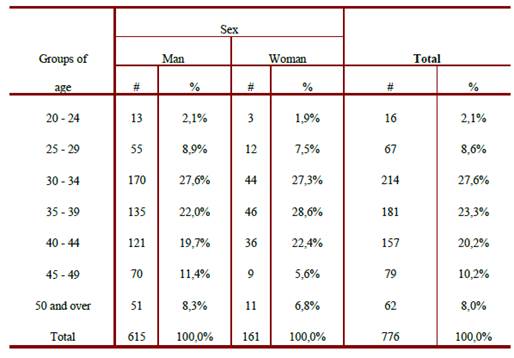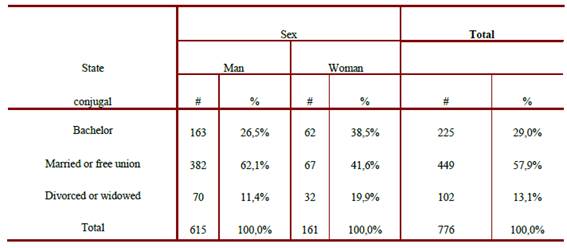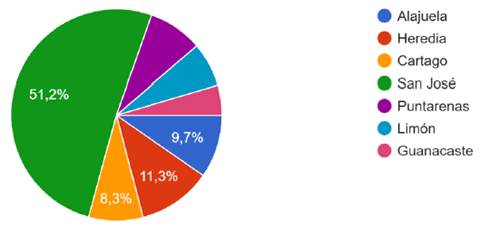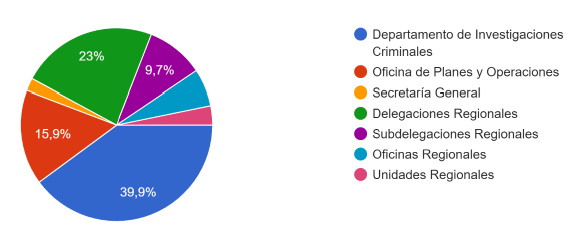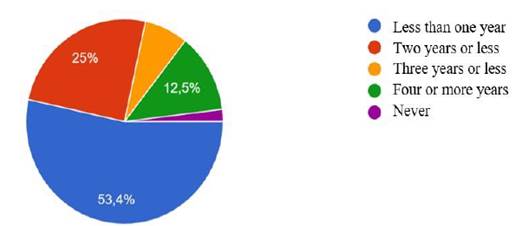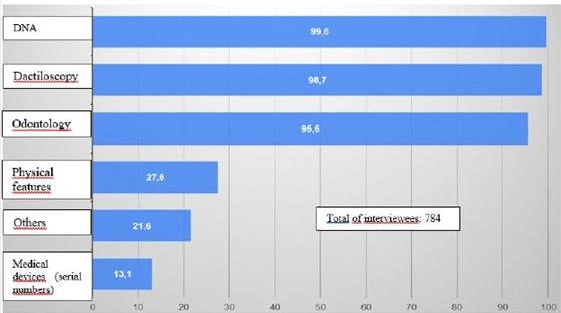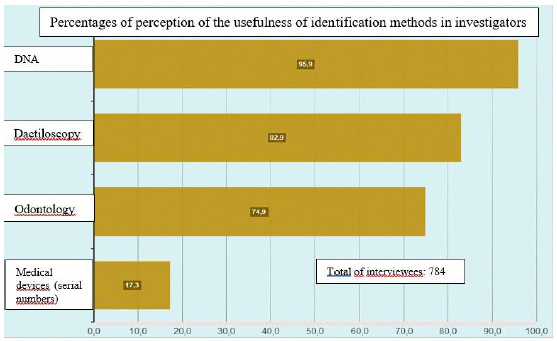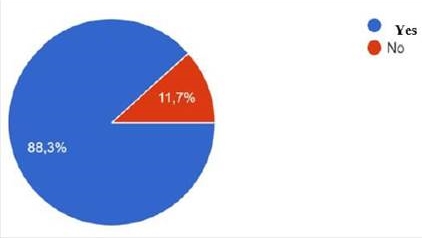Services on Demand
Journal
Article
Indicators
-
 Cited by SciELO
Cited by SciELO -
 Access statistics
Access statistics
Related links
-
 Similars in
SciELO
Similars in
SciELO
Share
Medicina Legal de Costa Rica
On-line version ISSN 2215-5287Print version ISSN 1409-0015
Med. leg. Costa Rica vol.39 n.1 Heredia Jan./Mar. 2022
Original Research
Perception of the usefulness of dental records as a method of human identification in high-risk professions: the case of the OIJ investigators
1. Espec. Odontología Forense. Patología y Cirugía Oral. M.Sc. Administración de Servicios de Salud Sostenible. Profesor Facultad de Odontología Universidad de Costa Rica. Unidad de Odontología Forense, Departamento de Medicina Legal, Organismo de Investigación Judicial. Heredia, Costa Rica. ORCID ID: https://orcid.org/0000-0001-6478-5407
Introduction:
People who work in criminal investigations are exposed to a high risk of suffering injuries or dying during operations against organized crime that can cause conditions that make identification difficult by conventional methods. This research was carried out in the investigators of the Organismo de Investigación Judicial (Judicial Investigation Agency) to establish the perception of the usefulness of dental records as a method of identification and to elaborate a unique format of dental information antemortem.
Materials and methods:
A pilot questionnaire was designed and applied to 10 people to be calibrated and validated. Subsequently, a final electronic questionnaire was generated on the Google Forms platform that was sent via institutional email to all the investigators consisting of 1200 individuals, of which 807 responded in the period of the June 21 to July 20, 2021. The results were analyzed by frequency distributions, crossing of variables, comparison of means based on the analysis of variance. The minimum confidence level for comparisons was 95%.
Results:
The questionnaire was conducted by 807 people, 79% men and 21% women. The mean age was 37.8 years (95% CI: 37.3 - 38.48) with no statistically significant difference (p=0.419), 80% work in the Central Region of the country, 78% indicate that they visited the dentist a year or less ago and 69% report that at some point they have taken a panoramic X-ray, 89% say they have dental treatments such as crowns, bridges or implants; and 88% consider dental records as a method of identification very useful, and place it in third place in knowledge (95.5%) when compared with DNA (99.6%) and dactyloscopy (98.7%).
Conclusions:
The investigators of the Judicial Investigation Agency consider that dental records are useful in the identification of human beings and have useful antemortem information for this purpose.
Key words: Criminal investigation; identification; dental records; perception; occupational risk
Introduction
Law enforcement officers and criminal investigators know they are part of a occupational high-risk team just like rescuers, paramedics, firefighters, and other emergency response teams who are exposed to dangerous environments and accidents during their work. (1)
The highest rates of fatal injuries according to occupational health studies correspond to law enforcement officers (police and investigators) along with fire fighters(1). The ratio of fatal injuries sustained to law enforcement officers in the line of duty in the United States of America is approximately 4:1 (14.2 per 100,000) compared to average workers (3.3/100,000),(2) in other studies it is estimated that the ratio can even reach 5:1 since there are 19.8 per 100,000 people. (3)
In a study period of 11 years, the main cause of death during the performance of duty of police officers and investigators was homicides with 47% and in second place traffic accidents 36%,(3) this generates high chances that the bodies may suffer alterations and conditions that generate difficulty in making an identification by facial recognition or dactyloscopy due to the destruction of the bodies, as is the case with the corpses of firefighters who die during their work(4).
The deaths of high-risk personnel can occur during daily work or during disasters that may be natural or man-made, including terrorist attacks such as the one at the World Trade Center (WTC) on September 11, 2001, which resulted in the deaths of 2,749 people, of whom approximately 421 were police and members of rescue teams (5-7 ).
In Costa Rica the number of firefighters killed during the last thirty years is very low, five people (three firefighters, two volunteers during the attention of a flood on November 4, 1994 in San Rafael de la Unión and the last firefighter died in March 2013. (8)
With respect to the personnel of the OIJ who have died during their work since its creation in 1973 until the beginning of this investigation, 21 people are counted, 18 men and 3 women, within the classification of their positions are investigators (as) , judicial experts, notifiers and protection officers (information provided by the General Director).
An adequate collection of antemortem dental data allows a reliable identification in a matter of hours, while erroneous antemortem dental information can generate confusion, delays and finally make it necessary to use more complex methods like DNA comparison due to lack of care or negligence of dental personnel. (9)
In the literature there is no evidence that there is any antemortem format designed specifically for identification purposes worldwide in police forces or rescue personnel, the only study where the perception of the usefulness of dental records in personnel of high occupational risk has been assessed was carried out in the personnel of Firefighters of Costa Rica . (8)
Materials and methods
A summary of the research project containing the general objective, specific objectives, as well as the justification and benefits for the Judicial Investigation Agency, was submitted to the Head of the Department of Legal Medicine of the Judicial Investigation Agency of Costa Rica; in addition, the pilot questionnaire reviewed by a statistician was attached to the document.
After obtaining authorization to initiate the investigation, the pilot questionnaire was applied to 10 investigators who made observations and comments; based on these it was corrected and calibrated again to be sent to the staff.
The final questionnaire was designed on the Google Forms platform and sent via institutional mail to all the investigators composed of 1200 individuals distributed in: Criminal Investigations Department, Plans and Operations Office, Regional Delegations, Regional Subdelegations, Regional Offices, Regional Units and General Secretariat.
The questionnaire included a header with a brief description of the project together with a consent and anonymity clause, as well as the possibility of completing only the general data; it was online from June 21 to July 20, 2021.
The results were analyzed by frequency distributions, crossing of variables, comparison of means based on the analysis of variance. The minimum confidence level for comparisons was 95%. The bibliographic review used in the present research was carried out through different virtual platforms such as Medline, Scielo and PubMed.
Results
The questionnaire was carried out by 807 people, of which 784 answered the complete questionnaire (97% of the sample), the remaining 3% only completed the sociodemographic data, it was applied from June 21 to July 20, 2021 by institutional email.
Gender and age
Regarding sex, 79% were men and 21% women, representing a ratio of 4:1. The average age of the interviewees was 37.8 years (95% CI: 37.3 - 38.48) with no statistically significant difference (p=0.419) in the average age of men with respect to that of women, however it can be observed that women (see Table 1) present a higher concentration in the groups of younger ages while men are more evenly distributed among all ages.
Marital status
Regarding marital status, it is observed that 58% indicated that they were married or living together in a free union; in this aspect, there is a statistically significant difference according to sex (p=0.001); because women have a higher proportion as single, compared to men, while men in the married marital state or free union is higher with respect to women (see table 2).
Distribution by provinces
Eighty percent of the investigators work in the Central Region of the country considering the provinces of San José (51.2%), Heredia (11.3%), Alajuela (9.7%) and Cartago (8.3%). Mientras that 20% come from the provinces of Puntarenas (8.3%), Limón (6.7%) and Guanacaste (4.6%) as shown in Figure 1.
Administrative distribution of investigators
According to the data obtained, most of the investigators are in the Departamento de Investigaciones Criminales (Criminal Investigations Department) 39.9%, in second place at the level of Delegaciones Regionales (Regional Delegations) 23%, and in third place in the Oficina de Planes y Operaciones (Office of Plans and Operations) 15.9%. See Figure 2.
Medical devices, dental treatments and periodicity
Related to dental treatments, 88% of the interviewees indicate that they do not have plates, screws or metal prostheses on their body and 98% indicate that they do not have a medical device that has a unique identification number on their body, 37% of respondents indicate that at some point they have been asked if they have tattoos or scars on their body that are useful for identification.
Regarding periodicity, 53.4% of the interviewees indicated that they attended dental consultation a year or less ago; without finding a statistically significant difference by sex (p=0.565) or by age group (p=0.244),in addition 1.9% reported never having attended (Figure 3).
A sixty nine percent indicate that at some point they have taken a panoramic x-ray of the entire mouth finding a statistically significant difference by sex (p = 0.001) since women presented a higher proportion with respect to men. By age group, there was no statistically significant difference (p=0.508).
Eighty nine percent indicate having dental treatments such as crowns, bridges or implants; without being statistically significant by age group (p=0.408) or by sex (p=0.484).
Risk perception
About the perception of risk of the work they do, 86% perceive that it is high or very high without a statistically significant difference by sex (p = 0.496) although by age group (p = 0.005), since the older the age the lower is the perception of high risk, 49.1% report having been in situations that put their lives in danger.
Knowledge of identification methods
The identification method best known by investigators is DNA (99.6%) followed by dactyloscopy (98.7%) and dentistry (95.5%); it was also the combination of methods with the highest prevalence (Figure 4).
Perception of usefulness of identification methods in investigators
Regarding the mentions of the most suitable identification methods for high-risk professions such as investigators, the main one was DNA followed by dactyloscopy and odontology. See Figure 5.
Opinion on the development of dental records database for identification purposes
When asked if they considered it useful to create an antermortem dental record database for the identification of people who work in the OIJ, 88% indicated that it was very useful without finding a statistically significant difference by sex (p=0.603) or by age groups (p=0.919).. Figure 6.
Discussion
It is very important to highlight that of the entire population of investigators (1200) the questionnaire was carried out by 807 people, which represents approximately two thirds of the total, this sample size allows to have a real panorama of the opinion and characteristics of said population.
The number of women investigators corresponds to 21%,this percentage is even higher than in the United States of America where it corresponds to approximately 12%,(10) it is striking that women also have a greater concentration in the younger age groups and have a higher proportion as single compared to men.
The distribution by provinces of the investigators shows that most of it is concentrated in the Greater Metropolitan Area (GAM), especially in San José where more than half of the respondents are concentrated (51.2%), these data are similar to those obtained in research carried out in other high-risk professions in Costa Rica such as firefighters. (11)
According to data from the Crime Data Explorer of the Federal Bureau of Investigation of the United States of America during the year 2020, 576 officers were injured and one murdered, this number includes investigators from the FBI, the Department of Defense among others. (12) On the other hand it is worth mentioning that in that country statistics are also kept on all officers killed in the line of duty since 1786 and it is estimated at just over 22,000 officers. (10)
Among the most relevant data obtained is that 53.4% visited the dentist a year or less ago; and 69% say they have had a panoramic x-ray (of the entire mouth) that is extremely useful in identifying human beings. (13)(14) At this point there is a statistically significant difference by sex (p=0.001) since women presented a higher proportion with respect to men and this is common because in multiple studies it has been shown that women attend dental treatments more frequently than men. (15-18)
Another point that is worth highlighting is the perception of risk, where there is awareness and is valued as high or very high by the majority (86%) but this perception decreases as age increases (p = 0.005).
The usefulness of dental treatments as a method of identification when there is adequate antemortem information is simply enormous, because a person could be identified even by means of a single tooth if the information is of good quality, regardless of whether it is charred (19-25) and on the contrary an inadequate registration can delay and even prevent proper identification.
Soft tissue records for identification purposes are actually of little use because their characteristics are unstable over time (27-32), which is why it is preferred to use the odontogram, the records of treatments carried out and dental images because they are documented and filed by most professionals, (33)(34) in addition, a radiological image can be interpreted by any dental professional regardless of where they are.
Conclusions
This research shows that the investigators of the OIJ (Judicial Investigation Agency) consider that dental records are useful as a method of identification, in addition, a large majority attend dental consultation regularly and have clinical records that include panoramic radiographs.
The large participation in the questionnaire shows that there is interest of the staff in having means to facilitate their identification in case of death, especially at times when organized crime has increased levels in recent years.
It is striking that there are no protocols in the literature where antemortem information is obtained from personnel who are exposed to high occupational risk, neither in Costa Rica nor worldwide, so implementing a format for identification purposes is a prevailing need.
The identification by dental methods is reliable, fast and economical, so it is recommended to implement the protocol in the Judicial Investigation Agency, as a pilot plan in the investigators and if possible, to all its personnel in the medium term.
Thanks
To the Organismo de Investigación Judicial for allowing this investigation to be carried out, especially to the M.Sc. Walter Espinoza Espinoza and Dr. Franz Vega Zúñiga for showing interest in developing this project.
To M.Sc. Jacqueline Castillo Rivas, professor at the Faculty of Dentistry of the University of Costa Rica for her collaboration with statistical advice and analysis.
REFERENCES
1. Reichard AA, Jackson LL. Occupational injuries among emergency responders. Am J Ind Med [Internet]. 2010 Jan 1 [cited 2022 Jan 27];53(1):1-11. Available from: https://onlinelibrary-wiley-com.ezproxy.sibdi.ucr.ac.cr/doi/full/10.1002/ajim.20772 [ Links ]
2. Crifasi CK, Pollack KM, Webster DW. Assaults against U.S. law enforcement officers in the line-of-duty: situational context and predictors of lethality. Inj Epidemiol [Internet]. 2016 Dec 1 [cited 2022 Jan 27];3(1):29. Available from: http://www.ncbi.nlm.nih.gov/pubmed/27885587 [ Links ]
3. Tiesman HM, Hendricks SA, Bell JL, Amandus HA. Eleven years of occupational mortality in law enforcement: The census of fatal occupational injuries, 1992-2002. Am J Ind Med [Internet]. 2010 Sep 1 [cited 2022 Jan 27];53(9):940-9. Available from: https://onlinelibrary-wiley-com.ezproxy.sibdi.ucr.ac.cr/doi/full/10.1002/ajim.20863 [ Links ]
4. NIOSH Fire Fighter Fatality Map [Internet]. [cited 2021 Mar 4]. Available from: https://wwwn.cdc.gov/wisards/fffmap/ [ Links ]
5. Lawson JR, Vettori RL. Federal Building and Fire Safety Investigation of the World Trade Center Disaster The Emergency Response Operations (Draft) For Public Comment. [ Links ]
6. NFPA statistics - Firefighter deaths [Internet]. [cited 2021 Mar 4]. Available from: https://www.nfpa.org/News-and-Research/Data-research-and-tools/Emergency-Responders/Firefighter-fatalities-in-the-United-States/Firefighter-deaths [ Links ]
7. FDNY Fire Operations response on September 11. [ Links ]
8. Fernández Chaves JM. Perception of the usefulness of dental records as a method of human identification in high-riskprofessions: the case of the Costa Rican firefighters. Med Leg Costa Rica [Internet]. 2021 [cited 2021 Mar 19];38(1):146-56. Available from: http://www.scielo.sa.cr/scielo.php?script=sci_arttext&pid=S1409-00152021000100146&lng=en&nrm=iso&tlng=es [ Links ]
9. Lorkiewicz-Muszyńska D, Przystańska A, Glapiński M, Kociemba W, Zaba C. Difficulties in personal identification caused by unreliable dental records. J Forensic Leg Med. 2013;20(8):1135-8. [ Links ]
10. Law Enforcement Facts - National Law Enforcement Officers Memorial Fund [Internet]. [cited 2022 Feb 27]. Available from: https://nleomf.org/memorial/facts-figures/law-enforcement-facts/ [ Links ]
11. Fernández Chaves JM. Percepción de la utilidad de los registros dentales como método de identificación humana en profesiones de alto riesgo: el caso de Bomberos de Costa Rica. Rev Med Leg Costa Rica [Internet]. 2021 [cited 2022 Feb 27];38(1):146-58. Available from: https://orcid.org/0000-0001-6478-5407 [ Links ]
12. CDE :: Documents and Downloads [Internet]. [cited 2022 Jan 21]. Available from: https://crime-data-explorer.app.cloud.gov/pages/downloads [ Links ]
13. Vijay Reesu G, Augustine J, Urs AB. Forensic considerations when dealing with incinerated human dental remains. 2014 [cited 2021 Mar 10]; Available from: http://dx.doi.org/10.1016/j.jflm.2014.10.006 [ Links ]
14. Woisetschläger M, Lussi A, Persson A, Jackowski C. Fire victim identification by post-mortem dental CT: Radiologic evaluation of restorative materials after exposure to high temperatures. Eur J Radiol. 2011;80:432-40. [ Links ]
15. ZANIN AA, HERRERA LM, MELANI RFH. Civil liability: characterization of the demand for lawsuits against dentists. Braz Oral Res [Internet]. 2016 Aug 18 [cited 2021 Sep 2];30(1). Available from: http://www.scielo.br/j/bor/a/8njjNnScdJP6hmQmyZ8Qq5g/?lang=en [ Links ]
16. Vega M J, Bedregal G P, Jadue H L, Delgado B I. Equidad de género en el acceso a la atención de salud en Chile. Rev Med Chil [Internet]. 2003 Jun [cited 2021 Sep 2];131(6):669-78. Available from: http://www.scielo.cl/scielo.php?script=sci_arttext&pid=S0034-98872003000600012&lng=es&nrm=iso&tlng=es [ Links ]
17. González Barrón S, Jiménez Corona ME, Triana Estrada J, Ureña Ciret JL, García Hernández J, Carrillo Rocha J de D, et al. Recomendaciones para mejorar la práctica odontológica. Rev CONAMED, ISSN-e 1405-6704, Vol 8, No 1 (Enero-Marzo), 2003, págs 29-38 [Internet]. 2003 [cited 2021 Sep 2];8(1):29-38. Available from: https://dialnet.unirioja.es/servlet/articulo?codigo=4052784&info=resumen&idioma=ENG [ Links ]
18. Terada ASSD, de Araujo LG, Flores MRP, da Silva RHA. Responsabilidad Civil del Cirujano-Dentista: Análisis de las Demandas Presentadas en el Municipio de Ribeirão Preto-São Paulo, Brasil. Int J Odontostomatol. 2014 Dec;8(3):365-9. [ Links ]
19. Dineshshankar J, Venkateshwaran R, Vidhya J, Anuradha R, Mary GP, Pradeep R, et al. Denture bar-coding: An innovative technique in forensic dentistry. J Pharm Bioallie d Sci [Internet]. 2015 Aug 2;7:S350-3. Available from: http://10.0.16.7/0975-7406.163450 [ Links ]
20. Sweet D. Forensic dental identification. [cited 2021 Mar 4]; Available from: www.forensicdentistryonline.org/Forensic_pages_1/ident_guidelines.htm. [ Links ]
21. Lain R, Taylor J, Croker S, Craig P, Graham J. Comparative dental anatomy in Disaster Victim Identification: Lessons from the 2009 Victorian Bushfires §. [ Links ]
22. Hanaoka Y, Ueno A, Tsuzuki T, Kajiwara M, Minaguchi K, Sato Y. Proposal for internet-based Digital Dental Chart for personal dental identification in forensics. 2006 [cited 2021 Mar 4]; Available from: www.elsevier.com/locate/forsciint [ Links ]
23. Vijay Reesu G, Woodsend B, Mânica S, Revie GF, Brown NL, Mossey PA. Automated Identification from Dental Data (AutoIDD): A new development in digital forensics. 2020 [cited 2021 Mar 4]; Available from: http://dx.doi.org/10.1016/j.forsciint.2020.110218 [ Links ]
24. Holobinko A. Forensic human identification in the United States and Canada: A review of the law, admissible techniques, and the legal implications of their application in forensic cases. Forensic Sci Int [Internet]. 2012;222(1-3):394. Available from: http://dx.doi.org/10.1016/j.forsciint.2012.06.001 [ Links ]
25. Krishan K, Kanchan T, Garg AK. Dental Evidence in Forensic Identification - An Overview, Methodology and Present Status. Open Dent J [Internet]. 2015 [cited 2017 May 5];9:250-6. Available from: https://benthamopen.com/contents/pdf/TODENTJ/TODENTJ-9-250.pdf [ Links ]
26. Fallas Morales L, Solís Corrales AL, Fernández Chaves JM. Lip prints analysis in a sample of dentistry students of the University of Costa Rica based in Renaud´s classification: Pilot Study. Med Leg Costa Rica. 2018 Sep;35(2):20-37. [ Links ]
27. Fernández Chaves JM. Morphological analysis of palatal rugae pattern in Costa Rican population. Rev Med Leg Costa Rica [Internet]. 2020 Sep [cited 2021 Mar 11];37(2):102-14. Available from: https://orcid.org/0000-0001-6478-5407 [ Links ]
28. Fonseca GM, David C, Flórez R. Propuesta de codificicación y análisis de rugosidades palatinas para su aplicaciòn en odontología antropológica y forense. ORAL Rev. 2009;(31):518-23. [ Links ]
29. Saxena S, Aeran H, Rastogi PK, Kadam A. Rugoscopy - An Emerging Aid For Personal Identification - A Review. Indian J Dent Sci [Internet]. 2013;5(4):150-3. Available from: https://liverpool.idm.oclc.org/login?url=http://search.ebscohost.com/login.aspx?direct=true&db=ddh&AN=94377191&site=ehost-live&scope=site [ Links ]
30. Selvamani M, Hosallimath S, Madhushankari, Basandi PS, Yamunadevi A. Dimensional and morphological analysis of various rugae patterns in Kerala (South India) sample population: A cross-sectional study. J Nat Sci Biol Med [Internet]. 2015 [cited 2017 Apr 16];6(2):306-9. Available from: http://www.ncbi.nlm.nih.gov/pubmed/26283818 [ Links ]
31. Ap I, Gupta M, David M, David MP, Lecturer S. Rugoscopy for Establishing Individuality. IJDA [Internet]. 2011 [cited 2017 Apr 16];3(1):427-32. Available from: http://www.rep.nacd.in/ijda/pdf/3.1.427.pdf [ Links ]
32. Mohammed RB, Patil RG, Pammi VR, Sandya MP, Kalyan S V, Anitha A. Rugoscopy: Human Identification by Computer-Assisted Photographic Superimposition Technique. J Forensic Dent Sci [Internet]. 2013;5(2):90-5. Available from: http://www.pubmedcentral.nih.gov/articlerender.fcgi?artid=3826049&tool=pmcentrez&rendertype=abstract%5Cnhttp://www.jfds.org/text.asp?2016/8/1/57/176967 [ Links ]
33. Fernández Chaves JM. Utilidad de expedientes odontológicos disponibles en Costa Rica en el año 2018 para la identificación de víctimas de desastres según el protocolo de INTERPOL. Rev Med Leg Costa Rica [Internet]. 2019 Mar [cited 2021 Mar 11];36(1):32-42. Available from: https://www.scielo.sa.cr/pdf/mlcr/v36n1/2215-5287-mlcr-36-01-32.pdf [ Links ]
34. Hernández Carazo D, Solano Romero K, Torres Guevara E, Trejos Cisneros JJ, Fernández Chaves JM. Determinación de la simbología más utilizada en expedientes odontológicos en Costa Rica en el año 2019 con fines de identificación de seres humanos. Med leg Costa Rica. 2020;37(1):179-91. [ Links ]
35. Vilchis-rea MA. acción participativa . Occupational risk factors in Mexican firefighters of four stations : participatory action - research. 2016;6(4):124-31. [ Links ]
36. Repositorio de la Universidad Internacional SEK Ecuador: Riesgos a los que se encuentran expuestos los bomberos aeronáuticos del Aeropuerto Internacional Mariscal Sucre de Quito durante una emergencia con aeronave (causa - efecto) [Internet]. [cited 2021 Mar 10]. Available from: https://repositorio.uisek.edu.ec/handle/123456789/3417 [ Links ]
37. Jordan HT, Stein CR, Li J, Cone JE, Stayner L, Hadler JL, et al. Mortality among rescue and recovery workers and community members exposed to the September 11, 2001 World Trade Center terrorist attacks, 2003-2014. Environ Res [Internet]. 2018 May 1 [cited 2020 Dec 9];163:270-9. Available from: https://creativecommons.org/licenses/BY-NC-ND/4.0/ [ Links ]
Received: January 10, 2022; Accepted: February 28, 2022











 text in
text in 


